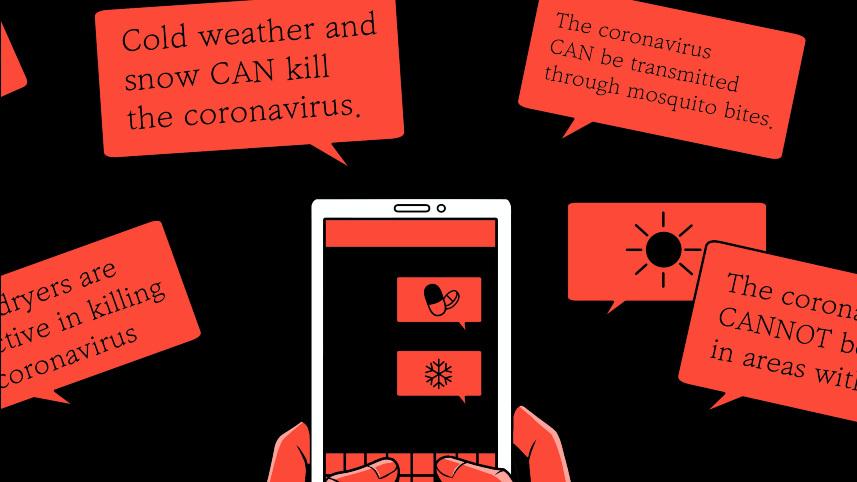Meaning and hope are two unifying characteristics of the COVID-19 misinformation that has run rampant on the Internet in Israel, according to Ayelet Baram-Tsabari. While 5G conspiracy theories, tales of miracle cures, and misinformation about masks may seem unrelated, they are united in that they provide their believers with comforting ways to understand a complex situation. There are many reasons for the spread of misinformation online, including algorithm-reinenforced echo chambers and lack of a consistent national communication strategy, but ultimately the messages spread because they appeal to people’s values and understanding of the world. A more worrying corollary: one reason for the rise of COVID-19 misinformation is that the scientific, medical, and public health communities have not been able to cultivate the same feelings of meaning and hope using evidence-based information.
The impact of misinformation is clear and terrifying. A recent study from the National Bureau of Economic Research found that in areas with higher consumption of TV shows spreading misinformation, there were more coronavirus cases—and more deaths. As we settle into a long winter with cases rising and a widely available vaccine still months away, it is important to understand how to communicate the science of the novel coronavirus in a way that creates meaning and hope while avoiding the encouragement of old conspiracy theories and the formation of new ones. At NCSE we spend a lot of time studying how best to communicate with people who doubt the scientific basis of evolution and climate change, so we’ve put together some tips on how to understand the rise of COVID misinformation and what you can do to help stop its spread.
Tip 1: Understand the Origins of Misinformation
First, let’s address a few misconceptions about misinformation. Though some studies suggest that certain types of people are more vulnerable to misinformation across the board, it is problematic to label all people who accept misinformation as “conspiracy theorists.” Many people believe strongly in one conspiracy theory while generally accepting science. Even those of us who aim to be informed by evidence-based science are susceptible to believing and amplifying voices that agree with us and ignoring or discrediting those that don’t. Accepting that we too are biased can be difficult, but recognizing our own biases can be instrumental in reorienting our thinking away from an “us versus them” perspective.
Once you’ve accepted that there is universal susceptibility to misinformation, it can be easier to appreciate the elements of conspiracy theories that appeal to people. In particular, look for the underlying human emotion that may be connected to the type of misinformation being shared. For example, people may believe in medical misinformation because of guilt that they could have taken more or better actions. Or they may believe that random events are connected because they feel a need for order. If you really want to counter misinformation effectively, you have to first identify and address the emotions driving the belief in misinformation. Mocking people for their belief, on the other hand, is likely only to reinforce their conspiracy theory of choice.
Tip 2: Address People’s Values
Faced with a public health crisis, scientists’ natural instinct is to share the facts. While facts are incredibly important, they can be overwhelmed by another type of evidence that many people (myself included) tend to prioritize: personal experience. In the case of COVID-19, the combination of delayed results, model uncertainty, and the (relative) rarity of spread lead to scenarios where one’s personal experience can, for a time, run counter to the facts.
It is possible to attend a large gathering, for example, without immediately developing COVID-19, just as it is possible to wear a mask and develop a cold a few days later. And that makes it harder to accept the facts that masks help to prevent the spread of the disease.
This doesn’t mean that we shouldn’t discuss facts, but we should contextualize them in a way that speaks first to people’s values, conveying messages of community. “Flatten the Curve” was a great slogan that called attention to the power of collective action, though it perhaps relied too much on an understanding of disease dynamics. This slogan communicated accurate information while also stressing that people had the power to do something to control the virus.
Tip 3: Don’t Forget the Messenger
While public trust in science and medicine is still relatively high, there are reportedly falling levels of public trust in major publications that convey accurate information about COVID-19 and other scientific topics. In the current politically polarized environment, the messages spread by trusted community members such as local nurses and religious leaders are incredibly important. They often know how to provide the message to their target community in a way that helps the audience listen, understand, and take action. Even if you aren’t in a position to spread information, you can seek to amplify these voices, particularly within your community. Ultimately, we must work to restore public trust in both science and national media outlets that communicate accurate, evidence-based science.
With the holidays fast approaching, you may have a chance to connect (in a socially distanced manner, please!) with far-flung members of your social network. For many of us, this will be a new chance to encounter COVID-19 misinformation spreading among family and friends. Use these tips to communicate the science of COVID-19 in a way that results in people listening.


